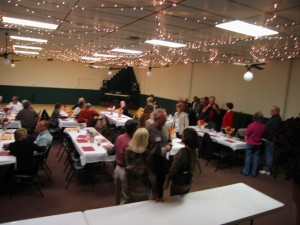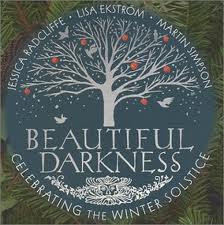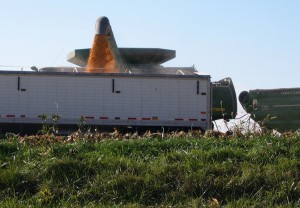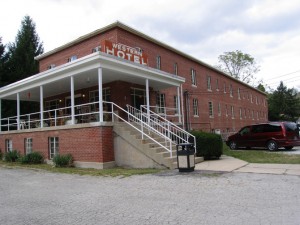Fall Waning Back to School Moon
October 3nd, Western Hotel, Camp Chesterfield 8:35 am
Had breakfast again in the Maxon Cafeteria, just east of the Western Hotel. It was late enough that the crowd here for John “Medicine Bear” Doerr’s workshop, Becoming a Spiritual Warrior, had already eaten, so I dined alone. Oatmeal and bacon.
A good nap after the laundromat yesterday followed by a quick visit to the gift shop here at the Camp. It reopens at noon today. Lots of interesting books and gee-gaws from a wide range of religious traditions. I’ll spend some money.
Big doings last night at the south room of the Norwood Bowl. A cement block addition to the bowling alley, the south room has a parquet dance floor, seating for around 70 which we filled  and a kitchen area;/wet bar raised above the dining and dancing floor by about three feet. It was a perfect space for this event.
and a kitchen area;/wet bar raised above the dining and dancing floor by about three feet. It was a perfect space for this event.
Having the homecoming parade float and the impromptu meal at the Curve on Friday night, the Historical Society meeting yesterday morning followed by the tented champagne brunch at Steve Kildow’s place before this sit down meal allowed a lot of mixing and story telling to happen over an extended time. It made for a real sense of having gathered together again as a class.
Toni Fox, a self-described “a bit plump but still cute as a button,” was an early crush of mine. By early I mean first/second grade. She’s retired now and set to go on a 1940’s train ride to Memphis with her now cancer free husband. Louie Bender worked his charm on the ladies as he always did, vying at times with Toni for the attention of the crowd.
Jerry Ferguson, an old buddy with whom I apparently had more good times than I recall, and I had a lot of laughs remembering crazy stuff we did. Jerry remembers, and others did too so I’ll take their word for it, that we painted 1965 on the water tower. He said, “I turned to you and you were high-tailing it for the truck. I yelled, Charlie, what are you doing?” “Man with a shotgun,” I shouted over my shoulder. Tom Urban got behind the wheel of Jerry’s green pickup, we dived in the back and Tom drove across the railroad track. Tony Fisher said, “We could see the whites of the engineer’s eyes.” Big fun. Lucky I survived childhood.
Tom Friend was there. He played coronet in high school and had a way with the ladies like Louie. Tom lived near the Nickel Plate tracks north just off Harrison.
Frank Johnson and Susan Mahoney, high school sweethearts and married since college, live in Fort Wayne. Frank had a benign brain tumor, quadruple by-pass surgery and prostate cancer. “I’m getting all the bad stuff out of the way before retirement.” He should be almost bullet proof. Susan, who looks like she did in high school, now works in admissions for a private school. They attend 1st Presbyterian in Fort Wayne, a congregation that tasted blood about 4 clergy ago and have continued to chum the water with each new pastor. A typical pattern for churches that succeed in ousting a minister, usually to devastating affect on the congregation.
Larry Stafford workdd for GM at Guide Lamp for 42 years until they shut down five or so years ago. Now, at 63, he’s out of a job and trying to find something new, “But, Charlie, there just aren’t any jobs out there. I got my associate degree in information management, too.” A tough spot.
Tony Fisher sells insurance in Liggonier, Indiana. A couple of years ago he won $2,000 dollars at an insurance convention, money for a trip. He chose New York City. “I didn’t know Central Park was so big you could drive through it. I saw Ellis Island and the Statue of Liberty, Ground Zero. I always wanted to see them. Course I also saw the wax museum and Ripley’s Believe or Not, too. I’d go back.”
Traveling is on his to do list. He wants to go Las Vegas for “all the glitz and glamor” and he also intends to take the South Bend to Chicago train and see the Shedd Aquairum and all that stuff. “Ive gotten interested in that stuff as I’ve gotten older.”
Steve Kildow, who paid for and hosted the champagne brunch yesterday worked at GM and lost a good bit of money when GM’s stock tanked. Looks to me like he compensated for it in other areas.
Old groups that hung out together 45 years ago reformed, catching up in the years since 1965 and reliving the ones before. Memories were the token of exchange over the weekend and each person came with a full account and left even richer in them.
A photographer took shots of the whole class, then broke us down by feeder schools: Orestes and Cunningham were outside Alexandria’s city limits, Tomlinson and Clarke were for the southern and northern parts of the city for elementary school. I didn’t even know Clark existed. We were only in Tomlinson and Clark for first and second grades then we merged at what is now Thurston Elementary.
Miss Thurston would come in to the lunch room, go student by student, rapping each on the shoulder, “Now Charles Paul. Eat your peas.”
Toni Fox recalled that when we went to Tomlinson the school took us home for lunch because the school was on Highway 9 and we couldn’t walk home. I didn’t remember that.
Richer Howard told me the saddest story of the evening. Richard Lawson, a good buddy while I was in High School, went to Vietnam and came back disabled. He married, had a couple of kids. A divorce took him hard and he lost his job, became homeless. Richie gave him money now and then.
It got to the point where Richard was living out of his car. He had a stroke and that made getting around difficult. During a recent very cold winter he had returned to his car, opened the door, then slipped and slid under it. They found him there the next morning, blue and solid.
Richie also told a tale about Richard. Richard joined the Navy after his discharge from the Army. Richie got a call at 3 am, “Hey, Richie. What’s you doin’?” “Sleeping.” “Hey, man. How do you cook a turkey?” “What?” Turns out Richie and some other sailors had washed up on the shore of Spain somehow and a farmer gave them a turkey, but non of them knew how to cook it.; Richie put his wife, Becky (Ellis, no relation), on the phone and she walked him through the steps.
There were, as there always are, those who couldn’t come. Ronnie Montgomery I missed most since we had stayed in contact through college. Zane Ward and Larry Cummings, part of the poker playing crew, I’ve not seen since high school. Zane runs the junk-yard and Larry has bait shop in Arkansas.
Jerry said Jack Staley has his own engineering firm specializing in heating and cooling systems. Jack has the controls for Budweiser’s beer storage warehouses in his basement in Indianapolis. The warehouses are in St. Louis. Mike Taylor, the only African-American in our class, who moved before high school, also became and engineer specializing in high-end kitchens.
Willard Grubb, another poker player, is a pharmacist nearby.
We’ve had deaths, mostly cancer and brain tumors, but a heart attack whiled driving, too. That was Rodney Frost, the guy with whom I had my one and only fist fight. Mike Gaunt, my doctor’s kid, died a couple of years ago. One of the pretty girls in our class, Sherry Basset, died in 1989. Two died in Vietnam. I don’t whether 20 or so is a lot or a little for a class of 120. Since we’re all 63, the number will grow faster between reunions now.
The woman I met here yesterday from Bogota said that one of the things she admired about Americans was their loyalty to groups. “Coming all the way from Minnesota for people you knew 45 years ago. In Colombia it’s just go and live your life. That’s it.”
There were, too, the objects and places to which memories adhere, the house on the corner of Harrison and John that has the stone wall running along the sidewalk. When Mom and I would go downtown, I walked up the flat mortared slope and then along the top, watching my mom from high above. At the point where some steps broke up the run of the wall, I always looked in the yard and so the big doghouse built for their St. Bernard. The hill, which felt so big back then, down which I rode my skateboard. I got pulled over by the police and ticketed for being in the street. At city hall I looked up the ordinance and found that wheeled vehicles were required to be in the street.
Those two numinous blocks of Monroe Street where I lived from age 4 or 5 to age 12 were the terrain of magic for me, where nights became playgrounds for hide and seek and kick the can, where a field nearby became a fort, a hide-out, a place of refuge, where Mike Hines and I performed our experiments where explosion was the mark of success.
In 1957 Mike and I were out back in our backyard, we lived across the alley from each other. We looked up and saw three silver shaped objects high in the late afternoon sky. To my recollection this was September or October. We watched those objects for a while, then they went behind the moon. That’s right, behind the moon. Mike and I reported this to my dad who wrote a small article in the paper about it. This was the time of the UFO’s and Mike and I saw some. Nothing ever came of our sighting.
Mike left the US during the Vietnam War for Canada. According to Toni, who saw Mike’s sister Susan not long ago, he’s still there.
Some of us had grown up on the same street together, then gone to elementary, junior high and high school together. We passed from children to youth to teen-agers together. Those memories, those years together in the same place are a powerful bond, one not broken by time or physical separation. We proved that all over again at this weekend.

 share a darkness dispelling theme with the others.
share a darkness dispelling theme with the others. not yet over and will go on until the ground threatens to become hard.
not yet over and will go on until the ground threatens to become hard.
 worked, Johns-Manville has nothing left but concrete coated pillars and a loading dock. I worked as a receiving clerk the summer I was there, so I knew exactly what went on there when the trains loaded with coak and limestone rolled onto the factory grounds.
worked, Johns-Manville has nothing left but concrete coated pillars and a loading dock. I worked as a receiving clerk the summer I was there, so I knew exactly what went on there when the trains loaded with coak and limestone rolled onto the factory grounds.
 and a kitchen area;/wet bar raised above the dining and dancing floor by about three feet. It was a perfect space for this event.
and a kitchen area;/wet bar raised above the dining and dancing floor by about three feet. It was a perfect space for this event.